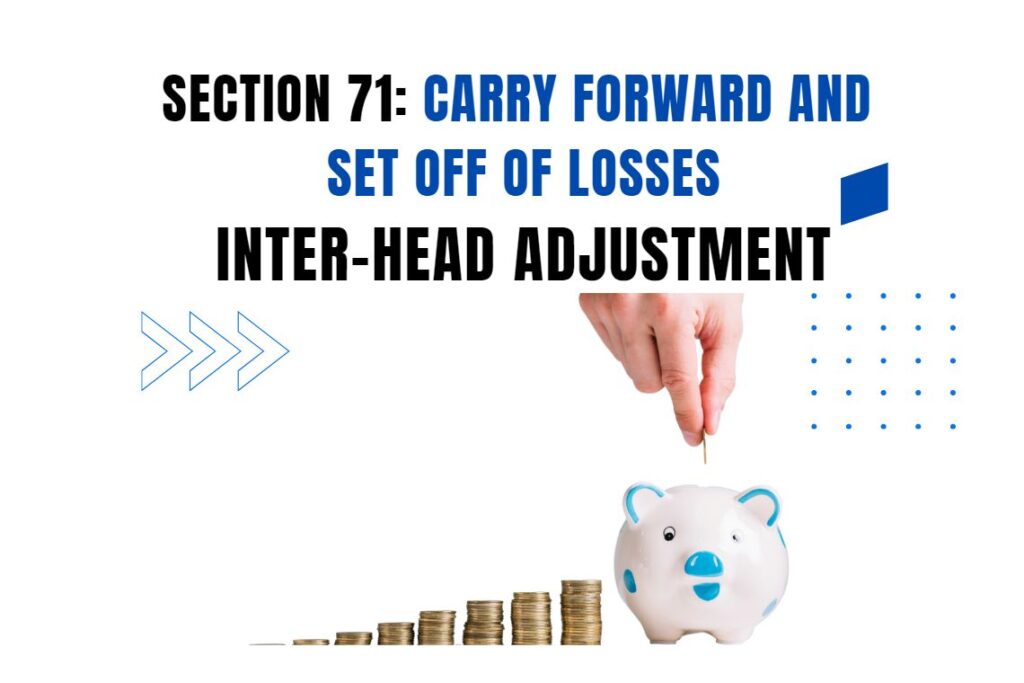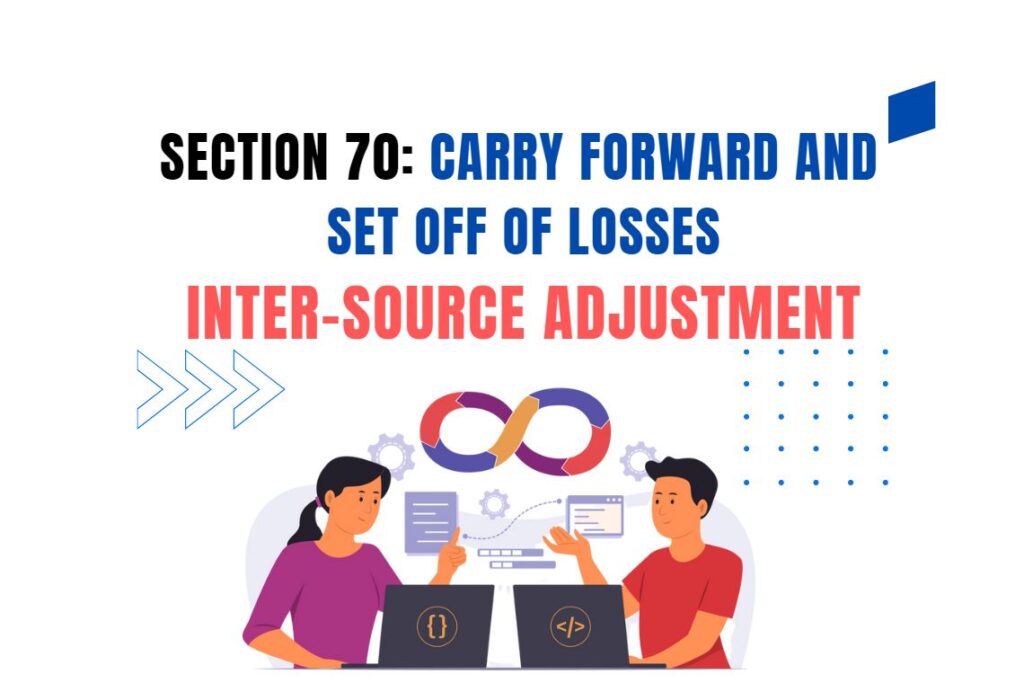(1) Introduction to Section-71 (Inter-Head Adjustment)
Under the Indian Income Tax Act, 1961, taxpayers are allowed to set off losses incurred under one head of income against income earned under another head of income. This provision is known as inter-head adjustment and is governed by Section 71 of the Income Tax Act.
Section 71 allows taxpayers to adjust losses from one head of income against income from any other head of income, subject to certain conditions and limitations. This provision helps taxpayers to minimize their tax liability by offsetting losses against income, thereby reducing their overall taxable income.
Conditions for Inter-Head Adjustment
There are certain conditions that need to be fulfilled for inter-head adjustment to be allowed:
· The loss should be incurred in the same assessment year.
· The loss should be a result of a business or profession carried on by the taxpayer.
· The loss should be classified under one of the specified heads of income.
Limitations on Inter-Head Adjustment
While inter-head adjustment is allowed under Section 71, there are certain limitations to be aware of:
· The amount of loss that can be set off against income from another head is subject to certain specified limits.
· Losses from the head of income ‘Capital Gains’ cannot be set off against income from any other head.
· Losses from the head of income ‘Income from Other Sources’ can only be set off against income from the same head.
Carry Forward of Unadjusted Losses:
If the losses cannot be fully set off in the current year due to insufficient income or other limitations, the unadjusted losses can typically be carried forward to future years. The carry-forward and set-off of losses are subject to certain conditions and time limits as specified by the Income Tax Act.
| Example:
· Let’s say you have a business that incurred a loss of Rs. 100,000 during the financial year. Additionally, you earned Rs. 60,000 from a rental property. · Under Section 71, you can set off the loss from the business (Profits and Gains of Business or Profession head) against the rental income (Income from House Property head). · As a result, your taxable income from the Income from House Property head will be reduced to Rs. 60,000, and the remaining loss of Rs. 40,000 can be carried forward to future years for set-off against income from the same head. |
Importance of Inter-Head Adjustment
Inter-head adjustment plays a crucial role in the taxation system as it allows taxpayers to optimize their tax liability. By setting off losses against income, taxpayers can reduce their taxable income, which in turn decreases the amount of tax they are required to pay.
For example, if a taxpayer incurs a loss from a business or profession, they can set off this loss against income from salary or house property. This reduces their overall taxable income and consequently lowers their tax liability.
(2) Loss under the head ‘Business Or Profession’ cannot be set off from income under the head ‘Salaries’ [Section 71(2A)]:
Section 71(2A) which states that loss under the head ‘Business Or Profession’ cannot be set off from income under the head ‘Salaries’.
Where in respect of any assessment year, the net result of the computation under the head “profits and gains of business or profession” is a loss and the assessee has income assessable under the head “Salaries”, the assessee shall not be entitled to have such loss set off against such income. However, it shall be allowed to set off from income under any other head.
Understanding the provision
Section 71(2A) of the Indian Income Tax Act, 1961 specifies that if an individual incurs a loss under the head ‘Business Or Profession’, this loss cannot be set off against income earned under the head ‘Salaries’. This means that if you have a salaried income and also run a business or profession which incurs a loss, you cannot use this loss to reduce your taxable income from salary.
This provision was introduced to prevent individuals from misusing the losses incurred under the head ‘Business Or Profession’ to reduce their tax liability on their salaried income. The rationale behind this provision is to ensure that losses from business activities are only set off against income generated from such activities and not against income from other sources.
Illustration of the provision
Let us consider an example to understand this provision better. Mr. A is a salaried individual earning a monthly income of Rs. 50,000. He also runs a business of selling handmade products. Unfortunately, in a particular financial year, his business incurs a loss of Rs. 2,00,000.
Now, if Section 71(2A) did not exist, Mr. A could have set off this loss against his salaried income and reduce his taxable income from salary. However, due to this provision, Mr. A cannot set off the loss from his business against his salaried income. As a result, he will have to pay tax on his entire salaried income of Rs. 6,00,000 (Rs. 50,000 per month for 12 months) without any adjustment for the loss incurred in his business.
Implications for individuals
The provision of Section 71(2A) has significant implications for individuals who have both salaried income and income from a business or profession. It means that any losses incurred in the business cannot be used to offset the tax liability on the salaried income. This can result in higher tax liability for such individuals.
However, it is important to note that the loss incurred under the head ‘Business Or Profession’ can be carried forward and set off against income from the same head in future years. This provision allows individuals to carry forward the losses and reduce their tax liability in subsequent years when the business starts generating profits.
(3) Loss under the head ‘Capital Gains’ [Section 71(3)]:
Under Section 71(3) of the Indian Income Tax Act, 1961, losses under the head ‘Capital Gains’ can be set off against gains under the same head. This means that if you have incurred capital losses in a particular financial year from the sale of assets such as stocks, real estate, or other capital assets, you can offset these losses against capital gains you may have earned during the same financial year.
For example, if you incurred a loss from selling stocks (short-term or long-term) during the financial year, you can offset this loss against any capital gains you made from selling other stocks or assets in the same financial year. This helps in reducing your overall taxable capital gains.
However, it’s important to understand that capital losses can typically only be set off against capital gains and not against income from other heads such as ‘Salaries’ or ‘Business or Profession.’ Additionally, there are rules regarding carry-forward of unadjusted capital losses to future years, which may be subject to certain conditions and limitations as per the Income Tax Act.
(4) Loss under the head ‘Income from House Property’ allowed to be set off from any other head upto Rs. 2,00,000 [Section 71(3A)]:
Loss set off is an important concept in the Indian Income Tax Act, 1961 that allows taxpayers to offset their losses from one head of income against income from another head. One such provision is Section 71(3A) which specifically deals with the set off of losses under the head ‘Income from House Property’.
Under this provision, taxpayers are allowed to set off the loss incurred from house property against income from any other head up to Rs. 2,00,000. This means that if you have incurred a loss from your house property, you can adjust it against your income from salary, business, or any other source.
Let’s understand this provision in detail:
Loss Set Off under Section 71(3A)
Section 71(3A) of the Indian Income Tax Act, 1961 provides relief to taxpayers who have incurred a loss under the head ‘Income from House Property’. According to this provision, the loss can be set off against income from any other head up to a maximum of Rs. 2,00,000.
For example, if you have a loss of Rs. 1,50,000 from your house property and your income from salary is Rs. 5,00,000, you can set off the entire loss of Rs. 1,50,000 against your salary income. This will effectively reduce your taxable income to Rs. 3,50,000.
Conditions for Loss Set Off
While the provision allows taxpayers to set off their losses from house property, there are certain conditions that need to be fulfilled:
- The loss can only be set off against income from any other head and not against income from the same head. For example, you cannot set off the loss from your house property against income from another house property.
- The maximum amount that can be set off is Rs. 2,00,000. If your loss exceeds this limit, the remaining loss can be carried forward to subsequent years and set off against income from house property only.
- The loss can be set off in the same year in which it is incurred or carried forward to subsequent years. However, the maximum set off allowed in any year is limited to Rs. 2,00,000.
- The set off can be done voluntarily by the taxpayer while filing their income tax return. It is not done automatically by the income tax department.
Advantages of Loss Set Off
The provision of loss set off under Section 71(3A) provides several advantages to taxpayers:
- Reduction in taxable income: Loss set off allows taxpayers to reduce their taxable income by adjusting the loss incurred from house property against income from other heads. This helps in lowering the overall tax liability.
- Optimal utilization of losses: Losses from house property can be set off against income from any other head, providing flexibility to taxpayers in utilizing their losses effectively.
- Carry forward of losses: If the entire loss cannot be set off in a particular year, the remaining loss can be carried forward to subsequent years and set off against income from house property. This helps in maximizing the benefit of losses.
Examples of Section 71(3A)
Example
Suppose, in the previous year 2021-22, income from property A is Rs.1,40,000 and from property B there is a loss of Rs.4,80,000. Besides this, there is an income under the head ‘salary’ amounting to Rs.6,00,000.
In this case, loss of Rs.4,80,000 of property B will first be set off from income from property A to the extent of Rs.1,40,000 as per section 70. The net loss of Rs.3,40,000 under the head ‘income from house property’ will be allowed to be set off from income under the head ‘salary’ to the extent of Rs.2,00,000 as per section 71(3A) and the balance of Rs.1,40,000 shall be carried forward to claim it as set off from income under the head ‘house property’ of the subsequent assessment year.
Note.— If an individual or HUF opts to be taxed under section 115BAC, the loss under the head ‘income from house property’ shall not be allowed to be set off from any other head of income. However, it will be allowed to be carried forward to claim it as set off from income under the head ‘house property’ in the subsequent assessment years as per section 71B.
As already discussed, in the following cases as intra-head adjustment was not permitted, hence, inter-head adjustment will also not be permitted:
(a) Loss from a speculation business;
(b) loss from a specified business referred to in section 35AD;
(c) Loss from the activity of owning and maintaining race horses;
(d) Loss of lottery, etc., cannot be set off against winnings from lotteries, crossword puzzles, card games, etc.;
(e) Loss from a source which is exempt.
Example:
From the following information submitted to you, compute the total income of A for the assessment year 2022-23 and calculate his tax liability assuming he is not allowed any deduction under sections 80C to 80U and he does not opt to be taxed under section 115BAC.
| Rs. | |
| Income under the head ‘Salaries’ | 3,00,000 |
| Income under the head ‘House Property’ | 40,000 |
| Business Loss | (-) 1,90,000 |
| Loss from a specified business referred to in Section 35AD | (-) 60,000 |
| Short-term Capital Loss | (-) 60,000 |
| Long-term Capital Gain | 2,40,000 |
Solution :
| Rs. | Rs. | |
| Income from Salary | 3,00,000 | |
| Income from House Property | ||
| Income | 40,000 | |
| Less: Business loss adjusted | (-) 10,000 | |
| Business Loss | (-) 1,90,000 | |
| Less: Set off against capital gain | 1,80,000 | |
| Less: Set off against house property income | 10,000 | NIL |
| Loss from specified business not allowed to be set off | (-) 60,000 | |
| Income from Capital Gain | ||
| Long-term Capital Gain | 2,40,000 | |
| Less : Short-term Capital Gain | 60,000 | |
| 1,80,000 | ||
| Less : Business Loss Adjusted | 1,80,000 | NIL |
| Gross Total Income | 3,30,000 | |
| Less : Deductions | NIL | |
| Total Income | 3,30,000 | |
| Tax on Rs. 3,30,000 | 4,000 | |
| Less : Rebate under Section 87A (100% of tax or Rs.12,500, whichever is Less) | 4,000 | |
| Tax Payable | NIL |
1. Business loss should first be set off from long-term capital gain as the long-term capital gain is taxable @ 20% whereas the income from house property, in this case, is taxable @ 5%.
2. It may be noted that business loss cannot be set off against income under the head ‘salary’.





